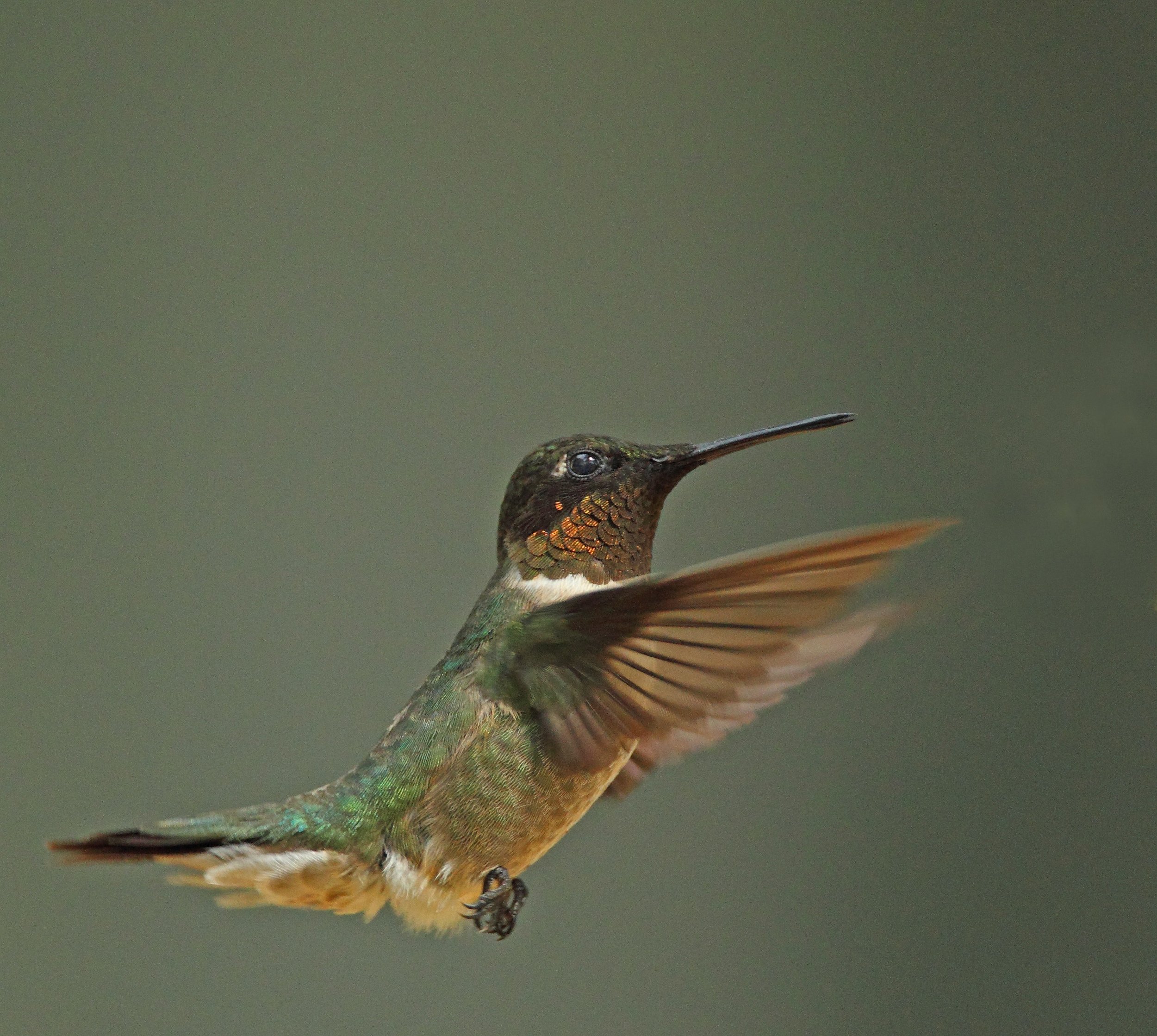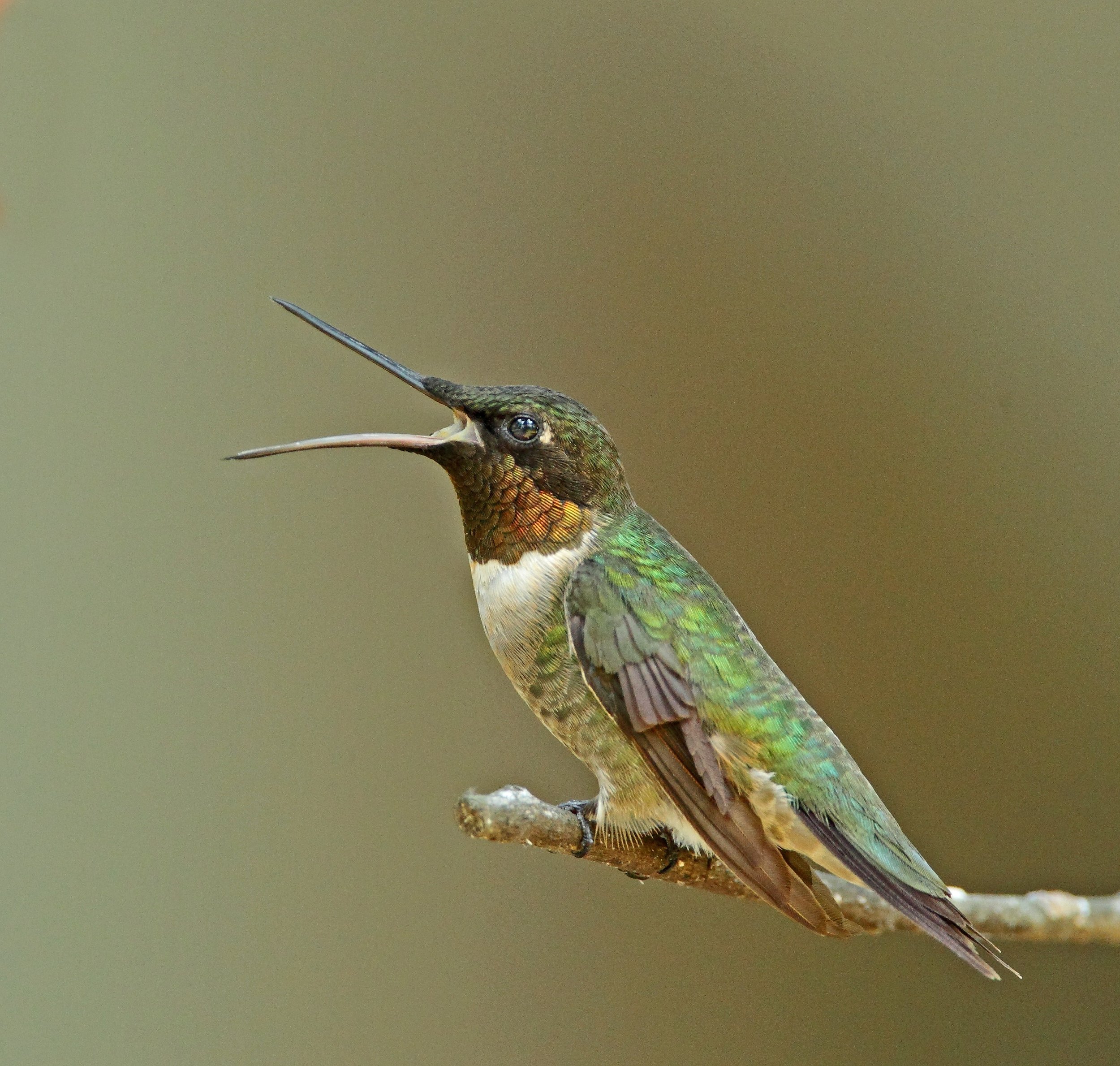Tiny Treasures: Discovering the Ruby-Throated Hummingbird
by Mallory Sanchez
Photo courtesy of Mac Womack.
Ruby-Throated Hummingbirds dazzle the Texas east coast every year with their brilliant colors and lively personalities. Measuring at only about 3.5 inches and weighing less than a quarter of an ounce, these tiny powerhouses have many wonderful adaptations to survive. The males are easier to identify due to their brilliant red throats, while the females have white throats. Both males and females have green on the rest of their bodies except for their white chests and bellies.
The wings of a hummingbird are a marvel in itself. They must be in a constant state of motion while in the air. Hummingbirds can use their wings to fly up, down, forwards, backwards, and hover. These flight abilities require a high amount of energy to produce. The breast muscles of a hummingbird are so large that they account for about a third of the bird’s overall weight. They must feed every ten to fifteen minutes to keep their bodies fueled for survival. To rest at night, hummingbirds go into a state of torpor, a hibernation-like state, in which they are unable to move. While in the torpor state, the amount of energy required by their bodies is reduced.
Hummingbirds use their long and sharp bills to get nectar from flowers. Their tongues can extend out from their bills and are one of the few birds that can do this. Hummers have a unique bone structure in their skulls which allows the long tongue to wrap completely around the back of their skulls. The end of a hummingbird’s tongue is forked and splits open to create a kind of fluid trap for collecting nectar. The tip of the tongue also has lamellae (hair-like extensions) around the edges to help with gathering more nectar.
Hummingbird Habitats
Ruby-throated hummingbirds generally live in semi-open habitats such as gardens, forests, and meadows during the summer. Hummingbirds utilize open areas containing flowers during migration and spend winters in tropical shrub areas. Food sources include nectar from plants with tubular flowers, hummingbird feeders, and also small insects for protein. They can catch insects out of the air while in flight! Hummingbirds play an important role as pollinators as they collect nectar. Pollen is transferred between the flower and the bird’s head as it moves from flower to flower.
One of the most fascinating things about ruby-throated hummingbirds is their seasonal migration that covers 2,500 miles from Alaska to Mexico. On this migrational path, they fly 500 miles over the Gulf of Mexico without any pit stops. This is where the Texas east coast comes in! A large concentration of hummers will spend several weeks along the coast (mid-March through mid-November) to mate, breed, and store up fat before they depart south to Mexico and Central America for the winter season.
Hummingbird Gardens
Photo courtesy of Mac Womack.
We can support hummingbirds by creating habitats to support their basic needs: nectar, insects, shelter, and water. Nectar sources include plants with tubular shaped flowers or hummingbird feeders. Be aware of blooming times in your garden so that you can have flowers available throughout the year, especially during the fall and winter months when the ruby throated hummingbirds are migrating south. If using a feeder, it is important to change out the sugar mixture and clean the feeder regularly. To attract small insects, grow plants with large, flat flowerheads. A garden with some open space containing trees, shrubs, and bushes provide valuable shelter for hummers. To find more information about specific plants to grow in a hummingbird garden and detailed instructions on setting up feeders, visit the Houston Audubon resource here.
Water is another important resource needed by all wildlife. Hummers stay hydrated through feeding on nectar and sugar water, but still need clean water to bathe and cool off in hot temperatures. If you place a water source in your garden, be mindful of the challenges that such a small bird can face using a common birdbath. They can access water by either flying through a mist or water that flows over a flat surface. Check out this article for more details on ways you can provide water.
Celebrating Hummingbirds
Photo courtesy of Mac Womack.
Rockport, Texas has the longest-running hummingbird festival in the U.S. The annual HummerBird Celebration occurs in September, when there is a high concentration of ruby-throated hummingbirds migrating through the area. Various activities are available for hummer lovers to enjoy these amazing birds. For more information about the festival, visit the Rockport-Fulton Area Chamber of Commerce page here. To learn more about the Ruby-throated hummingbird, see these resources:
Texas Parks and Wildlife Informational Flyer
Sources
“Ruby-Throated Hummingbird.” National Wildlife Federation, www.nwf.org/Educational-Resources/Wildlife-Guide/Birds/Ruby-Throated-Hummingbird. Accessed 30 July 2024.
“Hummingbirds.” TPWD, tpwd.texas.gov/publications/nonpwdpubs/introducing_birds/hummingbirds/. Accessed 30 July 2024.
The Texas Breeding Bird Atlas, txtbba.tamu.edu/species-accounts/ruby-throated-hummingbird/. Accessed 30 July 2024.
“Ruby-Throated Hummingbird.” Audubon, 29 June 2024, www.audubon.org/field-guide/bird/ruby-throated-hummingbird.



